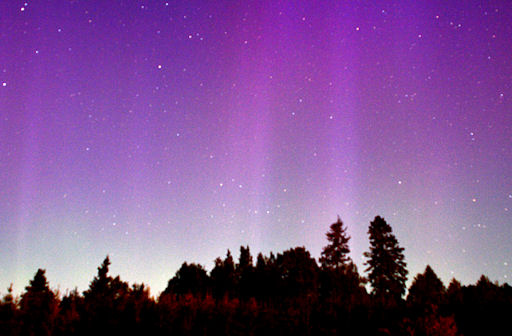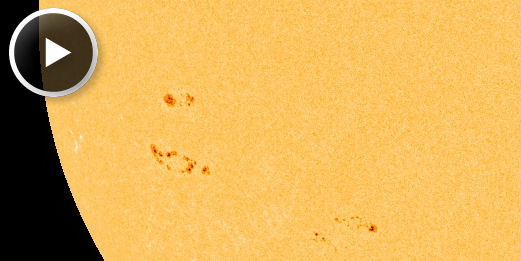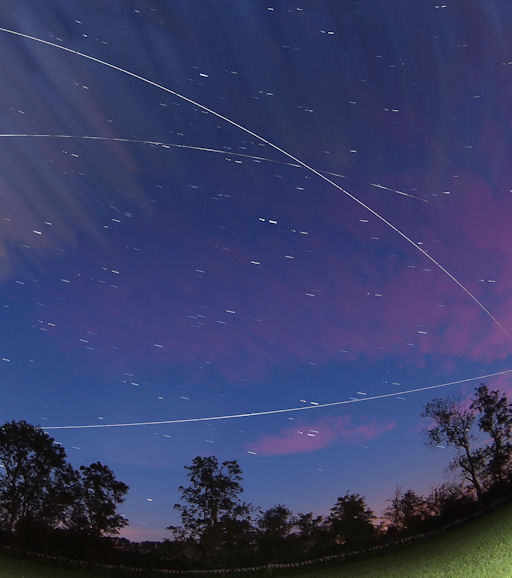They came from outer space--and you can have one! Genuine meteorites are now on sale in the Space Weather Store. | | |
SUBSIDING GEOMAGNETIC STORM: A minor geomagnetic storm that crested during the opening hours of June 12th is subsiding now. At maximum, it ranked 5 on the 0-to-9 K-index scale of magnetic disturbances and turned the skies purple over Dawsonville, New Brunswick:

"The auroras lasted just a couple of minutes, [but they were beautiful]," says photographer Bart Firth. "They were blue to purple in color."
The storm was sparked by an episode of "negative IMF." That is, south-pointing magnetic fields in the solar wind opened a crack in Earth's magnetosphere; solar wind poured in and fueled the display. NOAA forecasters estimate a 10% to 20% chance of similar storms in the next 24 hours as the solar wind continues to blow. Magnetic storm alerts: text, voice.
more images: from Guillaume Poulin of Cookshire, Québec, Canada; from Christopher Gregg of Mount Washington Observatory, New Hampshire; from Gilles Boutin of St-Michel Québec Canada;
SHAPE-SHIFTING SUNSPOT: As it pops and crackles with low level solar flares, sunspot AR1504 is rapidly evolving. During the past 24 hours the active region has shape-shifted from an irregular dumbbell into a dark ring of magnetism wide enough to circumscribe a half-dozen planet Earths:

NOAA forecasters estimate a 55% chance of M-class solar flares today as the sunspot's magnetic field shifts and destabilizes. Eruptions later this week could be geoeffective as the sunspot turns to face Earth. Stay tuned. Solar flare alerts: text, voice.
TRIPLE FLYBY: As the solstice approaches on June 20th, the International Space Station is spending some extra time in the sun. Ironically, this means you're more likely to see it in the night sky. Mark Humpage photographed three ISS flybys over his home in Lutterworth UK on June 10th:

"There were actually four flybys this evening at 2207, 2343, 0119 and 0256 hrs, however, the first was clouded out," says Humpage. "I added a few bursts of flash just before the first flyby to light up the garden and then left the camera running all night. The following morning I extracted all the images and stacked them to produce the final composite."
Readers, now is a great time to look for the behemoth spacecraft glistening in sunlight among the stars. Flyby times are available on your smartphone or from Space Weather's Simple Satellite Tracker.
Potentially Hazardous Asteroids (
PHAs) are space rocks larger than approximately 100m that can come closer to Earth than 0.05 AU. None of the known PHAs is on a collision course with our planet, although astronomers are finding
new ones all the time.
On June 12, 2012 there were 1311 potentially hazardous asteroids.
Notes: LD means "Lunar Distance." 1 LD = 384,401 km, the distance between Earth and the Moon. 1 LD also equals 0.00256 AU. MAG is the visual magnitude of the asteroid on the date of closest approach. | | The official U.S. government space weather bureau |
| | The first place to look for information about sundogs, pillars, rainbows and related phenomena. |
| | Researchers call it a "Hubble for the sun." SDO is the most advanced solar observatory ever. |
| | 3D views of the sun from NASA's Solar and Terrestrial Relations Observatory |
| | Realtime and archival images of the Sun from SOHO. |
| | from the NOAA Space Environment Center |
| | the underlying science of space weather |

